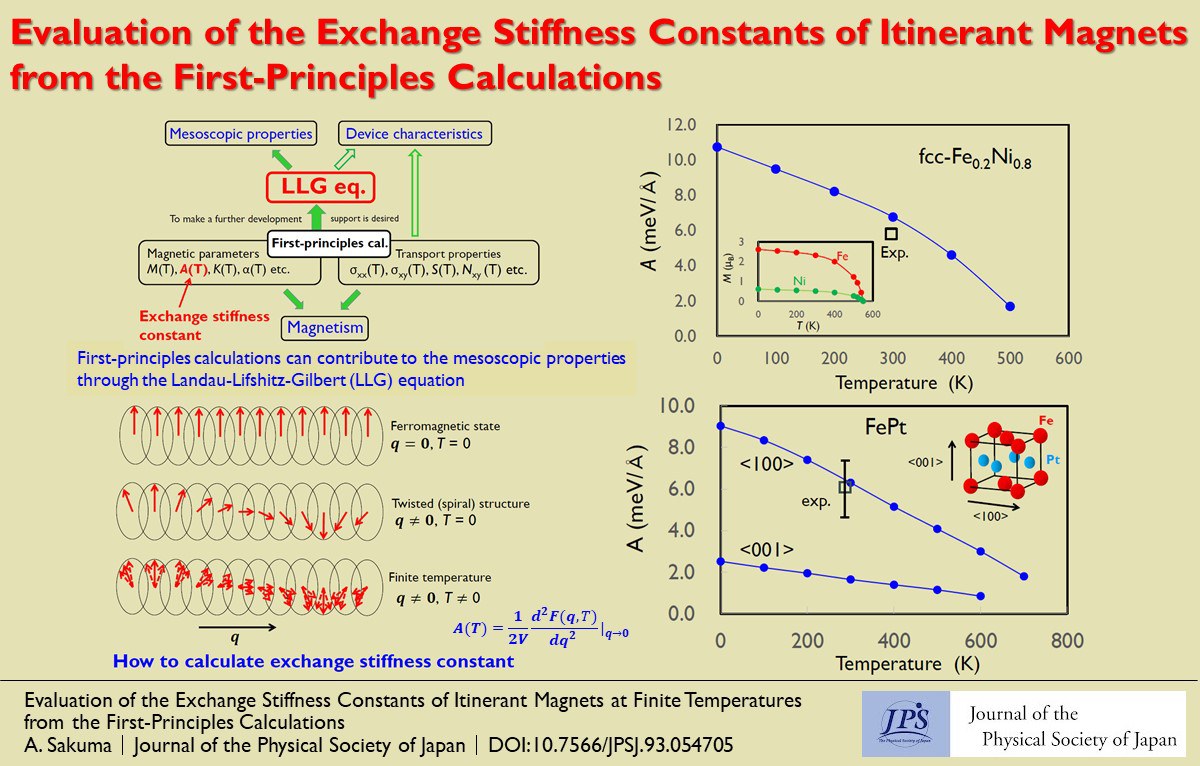Evaluation of the Exchange Stiffness Constants of Itinerant Magnets from the First-Principles Calculations
© The Physical Society of Japan
This article is on
Evaluation of the Exchange Stiffness Constants of Itinerant Magnets at Finite Temperatures from the First-Principles Calculations
(JPSJ Editors' Choice)
J. Phys. Soc. Jpn. 93, 054705 (2024).
Using first-principles calculations, we evaluated the exchange stiffness constants of ferromagnetic metals at finite temperatures. The constants can be used as parameters in the Landau–Lifshitz–Gilbert equation.

First-principles calculations based on electronic theory are powerful method for quantitatively representing the individuality of materials without the need for adjustable parameters. However, most industrial materials are far from perfect crystals and exhibit many defects such as vacancies, grain boundaries, and strains. Currently, it is difficult to describe the properties of these practical materials solely via first-principles calculations, and coarse graining based on the stiffness or characteristic length of order parameters is required. In such scale regions, the equations, such as the Landau-Lifshitz-Gilbert (LLG) equation for magnetism, are effective. This equation enables visualization of the macroscopic behavior of the order parameters (magnetization) in complex environments. Based on this perspective, the role of the first-principles calculations is to provide the parameters (magnetic constants) constituting the LLG equation.
The magnetic constants that constitute the LLG equation include the exchange stiffness constant (𝐴), magnetic anisotropy constant (K), and Gilbert damping constant (α). The issue arises because the interest in material properties predominantly focuses on room temperature or higher temperature regimes. Hence, the challenge involves determining the magnetic constants at finite temperatures from a microscopic standpoint. With respect to general metallic ferromagnets, functional integral methods have been powerful prescriptions for the finite temperature magnetism.
In this study, we focus on the first-principles calculations of the exchange stiffness constant 𝐴 at finite temperatures based on the functional integral method. The exchange stiffness constant is a measure of the rigidity (or hardness) of regular spin arrangements (such as ferromagnetic alignments) arising from the exchange interaction between spins. To evaluate 𝐴(𝑇), a spiral magnetic structure characterized by wavevector 𝑞 is generated in the presence of spin fluctuations. Subsequently, we can obtain 𝐴(𝑇) from the increase in free energy.
Specifically, we calculate 𝐴(𝑇) of Permalloy (Fe0.2Ni0.8) and L10-type FePt. For Fe0.2Ni0.8, the calculated magnetic moment is approximately 1 Bohr magneton (µB) at 𝑇 = 300 K, closely reproducing the measured values. The Curie temperature is approximately 550 K, slightly lower than the measured value (670 K). The obtained 𝐴(𝑇) falls within the range of values empirically used in the LLG equation (several meV/Å to 10 meV/Å), and 𝐴(𝑇) at room temperature appears to match well with the measured values. Additionally, 𝐴(𝑇) of FePt shows similar temperature dependence, aligning well with room temperature measurements. The results highlight the structure’s anisotropy, with significant directional dependence in 𝐴(𝑇).
Written by A. Sakuma
Evaluation of the Exchange Stiffness Constants of Itinerant Magnets at Finite Temperatures from the First-Principles Calculations
(JPSJ Editors' Choice)
J. Phys. Soc. Jpn. 93, 054705 (2024).
Share this topic
Fields
Related Articles
-
Electricity Provides Cooling
Magnetic properties in condensed matter
Structure and mechanical and thermal properties in condensed matter
Cross-disciplinary physics and related areas of science and technology
2024-10-15
Electric cooling at low temperatures is successfully achieved using a ferroelectric ferromagnetic solid instead of refrigerant gases such as fluorocarbons.
-
Pressure-Tuned Classical–Quantum Crossover in Magnetic Field-Induced Quantum Phase Transitions of a Triangular-Lattice Antiferromagnet
Magnetic properties in condensed matter
Electron states in condensed matter
Cross-disciplinary physics and related areas of science and technology
2024-9-5
The correspondence principle states that as quantum numbers approach infinity, the nature of a system described by quantum mechanics should match that described by classical mechanics. Quantum phenomena, such as quantum superposition and quantum correlation, generally become unobservable when a system approaches this regime. Conversely, as quantum numbers decrease, classical descriptions give way to observable quantum effects. The external approach to classical–quantum crossover has attracted research interest. This study aims to demonstrate a method for achieving such control in materials.
-
d2 Trimer and d3 Tetramer in a Pyrochlore Lattice
Dielectric, optical, and other properties in condensed matter
Electron states in condensed matter
2024-7-11
Based on the charge disproportionation of V3+ and V2+, the V3+(d2) trimers and V2+(d3) tetramers in the vanadium pyrochlore lattice of AlV2O4 are described by the orbitally-induced Peierls mechanism.
-
Which is Moving?—Pinning Down the Origin of Fluctuations in Muon Spin Relaxation—
Structure and mechanical and thermal properties in condensed matter
Cross-disciplinary physics and related areas of science and technology
2024-3-28
The study demonstrated that we can distinguish between the diffusion motion of the muon itself and the motion of the surrounding ions in muon spin relaxation.
-
Variety of Mechanically Induced Spin Currents in Rashba Systems
Electronic transport in condensed matter
Magnetic properties in condensed matter
Structure and mechanical and thermal properties in condensed matter
2024-3-22
Various types of spin currents, including unconventional types, are generated in Rashba spin-orbit coupled systems by dynamic lattice distortions associated with, for example, surface acoustic waves.
